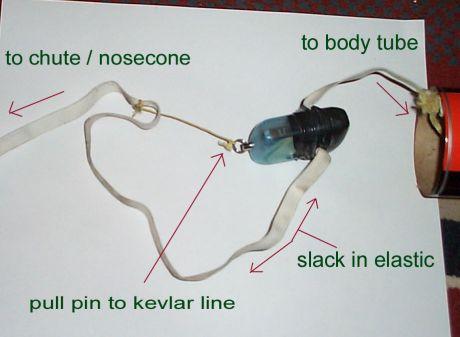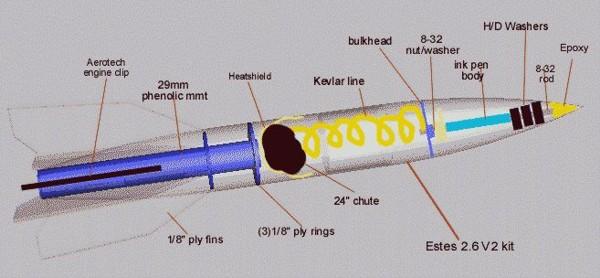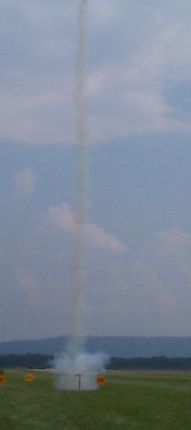| Published: | 2011-01-01 |
| Manufacturer: | Modification |
 Brief:
Brief:
This is a power-up of the discontinued Estes 2.6 V2 and of course I can't help it. I couldn't leave it stock, so I transformed the stock 24mm into a 29mm performer.
Modifications:
I started by using a 29mm phenolic MMT. I made custom rings from 1/8" aircraft ply. The fins are also 1/8" aircraft ply. Another ply ring is installed at the fore end of the MMT. Between this ring and the second ring is a section of BT-80 coupler for body tube strength. The very base of the nose cone was cut out and I installed an adjustable weight system.
I used West System Epoxy everywhere including the inside and outside fillets. I left the top ring out of the tail cone and applied fillets to all fin connection points and then installed the top ring. Fins are to the MMT. I also installed an Aerotech engine clip that will be further retained with a tywrap before launching.
A short spacer is installed before using s/u motors. It also uses 1/4" launch lugs.
Construction:
I used the stock tube and both cones. I feel that fiberglass is not as necessary as most people would like to convince me of and I can back up this claim with plenty of results. If you want something to last for 30 yrs go ahead with the glassing, but I don't feel it's necessary up thru level 1 rockets. I myself loose them eventually so why bother. It's just a bunch of un-necessary weight.
I did use the epoxy more than I usually do on this particular build, but I'm sure it could hold up to an H motor and that was the goal.
I painted it in the White Sands April 16, 1946 scheme except with a twist. It's orange and black rather than the yellow and black.
I used Duplicolor enamel and I have to admit, it glistens! Great paint!!
A Kevlarheatshield surrounds the 24" Topflight chute tethered by a Kevlarcord and elastic combo. The chute bay is also strengthened with a layer of thin cya. This puppy will fly well on F and G loads.
I made a beeper locater from one of those keychain panic alarms with the pull pin. I got this one at a drugstore for around $5.00. Basically, you attach the alarm body to your shock cord or possibly the body tube then you leave some slack in the shock cord and attach it to the pull pin so when the shock cord stretches out it pulls the pin. To make the adjustable nose weight, I cut off the nose cone base. Then I just epoxied a short length of threaded rod into the nose cone. Finally, I slid enough heavy-duty washers onto the rod to get the center of gravity back where I want it for the weight of the particular motor that I put in the rocket.

I made a sleeve from a cut off ballpoint pen body that holds the washers tight when I tighten a nut down on the rod. Then I added a piece that screws on the end of the threaded rod to attach the shock cord to.

I added a bulkhead (basswood disc) between the nut and shock cord attachment to keep the chute from wedging between the threaded rod and nose cone wall during ejection. The idea is to extend the range of motors that the rocket can safely fly on and still land in the same field... well sometimes.
I also always make sure that the lift off speed is fast enough before it leaves the launch rod. I used Rocsim for simulating things like this. I use a scale I bought from Office Depot to weight the rocket fully loaded after I actually flew the rocket and saw how it reacted. I was able to experiment a little more by adding and removing some weight in-between flights.
 Flight:
Flight:
I first launched it on a F-23 and she was straight as an arrow to about 900'. The personal alarm I added worked like a champ. You could hear it at apogee every time! A good $5 investment for any rocket.
Then I built up a G33 reload and launched her. Man!! That thing is smokey and louder than I remembered. It crackled like a HPR load! Not too fast but hit about 1800'.
The final flight was an F50. It literally exploded off the pad and again straight as an arrow. It kept going and going...1700'.
All 3 flights landed pretty close, very little if any wind cocking. Winds were avg 10-15 mph. What a great kit for the 29mm upgrade! The 24" chute was perfect for the sod farm.
At the next club launch. I again put a F50 in it, set it on the pad and got situated to take a pic when the LCO pressed the button. Bang! It was like a shot out of a cannon... and kept on going!! Too bad I had over adjusted the launch rod. It was over a treeline when the ejection fired. ONE square mile of sod and... I sent it over a tree line!!
On the way down, it was coming back to clear land but it caught the last tip top of the last tree...ohh so close!!! But just didn't make it over!
It's still there 35' up. I couldn't get it down but I gave it a good effort. R.I.P. (till I bring the bow saw to the next launch)
Summary:
the pic to the right shows just how fast it left the pad
If anyone can find one of these kits I highly recommend going to 29mm if you have the space to launch it and you are of the type who likes the neck snapping (non-scale) flights. Otherwise it's a great kit when left stock, especially on E9's.
Related Products
Sponsored Ads
 |
 |











